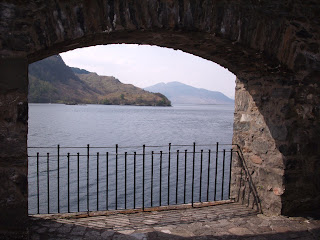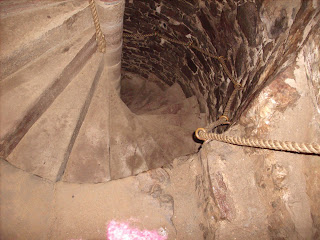 COSTUMED CHARAC-TERS WILL TAKE VISITORS BACK IN TIME AT STIRLING’S ROYAL PALACE
COSTUMED CHARAC-TERS WILL TAKE VISITORS BACK IN TIME AT STIRLING’S ROYAL PALACE
MINISTER WELCOMES RETURN OF RENAISSANCE GLORY TO CASTLE
T
he return of a host of Renaissance figures to Stirling Castle’s royal palace has been welcomed by Fiona Hyslop, Minister for Culture and External Affairs.
Among them will be the warrior and courtier Sir Norman Leslie of Rothes, the great poet Sir David Lindsay of the Mount, and maid of honour Lady Janet Fleming.
The costumed characters will show visitors round six apartments within the castle’s royal palace. 
These are being returned to how they may have looked in their glory days in the 1540s, when they were home to Scotland’s royal court.
The Minister said:
“The palace project will give visitors the nearest experience we can to time travel.
The interiors will look magnificent, and the chance to meet costumed characters will really bring the experience to life.
“A great deal of research has gone into getting the characters and their costumes exactly right for the period.
Visitors will be able to meet everyone from great nobles to the servants who kept palace life running for the royal court.
“The whole idea is to be fun and informative, providing a fantastic day out for the whole family.”
Other characters people will meet include the court official Alexander Stuart, and Sandy Charpentier who rose from being a simple potman (clearing tables) to become Keeper of the Queen’s Plate – in charge of the pewter and silverware.
The palace interiors are currently being returned to how they may have looked in the 1540s as the centrepiece of a £12 million investment at the castle.
The lords, ladies, bodyguards and servants portrayed by the interpreters will give an estimated 440,000 visitors a year a vivid insight into Renaissance life.
They will offer a mix of factual historical detail with drama and entertainment.
Sir Norman, Sheriff of Fife and royal confidante, will talk about palace life and politics, as well as offering lessons on etiquette should they bump into the dowager queen, Mary of Guise, or her young daughter Mary Queen of Scots.
Manners were very important and there are a number of books about how people should behave.
“One of the things Sir Norman will do is offer handy hints, for example that it was frowned on to pick fleas from your hair or clothes in the royal presence.
Visitors can find out about contemporary fashions and food, talking to servants as they lay out clothes ready for Mary of Guise or prepare for meals.
“They can also discover more about the troubled political situation, as young rival noblemen argue and even come to blows.”
The company has worked closely with Historic Scotland’s interpretation unit, and with academic experts, to ensure their scripts and costumes are authentic.
Peter Yeoman, Historic Scotland head of cultural resources, said:
“Visitors will step back into an incredibly eventful period of Scottish history, when the palace and castle were being used as a safe haven to bring up the infant Mary Queen of Scots to keep her beyond the reach of the English. The kingdom was torn between rival factions, with ambitious noblemen vying for power.
At the same time the Catholic royal family, and their French supporters, faced an upsurge in Protestantism, eventually leading to the Reformation.
“Despite all this the court was a colourful place filled with chatter, laughter, music, dance, feasting and entertainment.
While the Tudor court in England was a conservative place, ruled by the ageing, ill and bad-tempered Henry VIII, the Scottish court was far more informal, energetic and lively – headed by James V’s charming and witty widow, Mary of Guise.
“By having costumed interpreters in the palace we can give visitors a real sense of the delights and dangers of the 1540s.”
Palace life in the 16th century
● There were strict rules on cleaning the dishes – for example, if a servant spotted marks on a silver salver they were not to lick it clean.
● Knowing your place was important – mere servants were not to make eye contact with their betters.
● Ordinary folk working as servants at the castle would get their food for free – mainly bread and leftovers. They would not have bedrooms, but would kip in any cosy corner they could find.
● Fashion was tremendously important for a rich man or woman at court – something like a third of their income might go on clothes and they would change up to three times a day.
● Personal hygiene was a low priority for most people, though the rich would probably be given a daily strip bath by their personal servant.
● Mary of Guise, unlike many of England’s Tudors, did not tend to dine alone in the private recesses of the palace, but in public the Queen’s Outer Hall of the palace, where she mixed with lords, ladies, gentlemen and military officers.
● Top courtiers dined off trestle tables set up for their dinner. These would then be taken away so the room was clear for dancing and entertainment – perhaps from acrobats and jesters.
● When dining it was bad manners to throw bones on the floor, clean your teeth on the tablecloth or to spit.
● Children tended to be treated as miniature adults, but boys were dressed in skirts until the age of around five – at which time they were ‘breached’ and started to wear male clothes, such as breaches.
● The rich ate lots of red meat and little in the way of vegetables. They loved pies and there was an increasing taste for candied fruit and nuts, and even boiled sweets. But these were only enjoyed by the wealthy as sugar was incredibly expensive, imported all the way from Persia.
● Palace life started early, with servants making preparations for the day from around 5am but often snuffing out their candles at 8pm for some sleep.
● Royals, like Mary of Guise, had different hours. She would rise late, at around 10am, and stay up long into the night with her closest confidants. A special kitchen and staff were available if any of them fancied a snack.
● Stirling Castle is at the top of Stirling Old Town off the M9 at junction 9 or 10. Call 01786 450000
● Historic Scotland has 345 historic properties and sites in its care. These include some of the leading tourism attractions in the country, including Edinburgh, Stirling, and Urquhart Castles, Fort George, Linlithgow Palace, the Border Abbeys, and Skara Brae. For further details visit: www.historic-scotland.gov.uk/places.
● Historic Scotland’s Mission is to safeguard Scotland’s historic environment and to promote its understanding and enjoyment.
● Historic Scotland around the web: www.twitter.com/welovehistory, www.facebook.com – search for Make Your Own History, www.youtube.com/historicscotlandtv and www.flickr.com/groups/makeyourownhistory
 Scotland’s most important battlefields are continuing to be officially identified, after Historic Scotland announced the second of its three batches for inclusion in “The Inventory of Historic Battlefields”.
Scotland’s most important battlefields are continuing to be officially identified, after Historic Scotland announced the second of its three batches for inclusion in “The Inventory of Historic Battlefields”.







 Charming town of slate houses & three rivers, Betwys-y-coed, in North Wales.
Charming town of slate houses & three rivers, Betwys-y-coed, in North Wales.
























